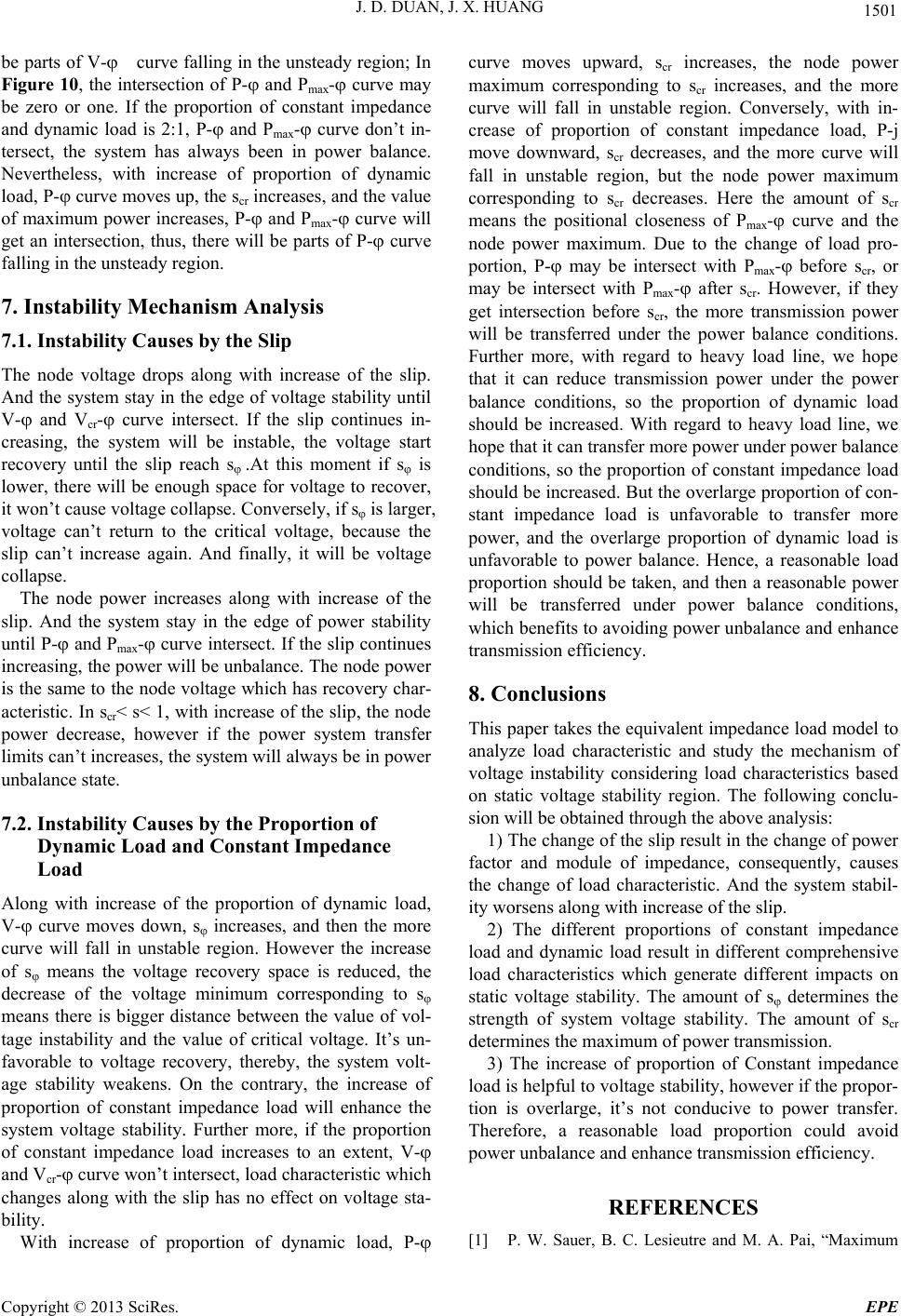
J. D. DUAN, J. X. HUANG 1501
be parts of V- curve falling in the unsteady region; In
Figure 10, the intersection of P- and Pmax- curve may
be zero or one. If the proportion of constant impedance
and dynamic load is 2:1, P- and Pmax- curve don’t in-
tersect, the system has always been in power balance.
Nevertheless, with increase of proportion of dynamic
load, P- curve moves up, the scr increases, and the value
of maximum power increases, P- and Pmax- curve will
get an intersection, thus, there will be parts of P- curve
falling in the unsteady region.
7. Instability Mechanism Analysis
7.1. Instability Causes by the Slip
The node voltage drops along with increase of the slip.
And the system stay in the edge of voltage stability until
V- and Vcr- curve intersect. If the slip continues in-
creasing, the system will be instable, the voltage start
recovery until the slip reach s .At this moment if s is
lower, there will be enough space for voltage to recover,
it won’t cause voltage collapse. Conversely, if s is larger,
voltage can’t return to the critical voltage, because the
slip can’t increase again. And finally, it will be voltage
collapse.
The node power increases along with increase of the
slip. And the system stay in the edge of power stability
until P- and Pmax- curve intersect. If the slip continues
increasing, the power will be unbalance. Th e node power
is the same to the node voltag e which has recovery char-
acteristic. In scr< s< 1, with increase of the slip, the node
power decrease, however if the power system transfer
limits can’t increases, the system will always be in power
unbalance state.
7.2. Instability Causes by the Proportion of
Dynamic Load and Constant Impedance
Load
Along with increase of the proportion of dynamic load,
V- curve moves down, s increases, and then the more
curve will fall in unstable region. However the increase
of s means the voltage recovery space is reduced, the
decrease of the voltage minimum corresponding to s
means there is bigger distance between the value of vol-
tage instability and the value of critical voltage. It’s un-
favorable to voltage recovery, thereby, the system volt-
age stability weakens. On the contrary, the increase of
proportion of constant impedance load will enhance the
system voltage stability. Further more, if the proportion
of constant impedance load increases to an extent, V-
and Vcr- curve won’t intersect, load characteristic which
changes along with the slip has no effect on voltage sta-
bility.
With increase of proportion of dynamic load, P-
curve moves upward, scr increases, the node power
maximum corresponding to scr increases, and the more
curve will fall in unstable region. Conversely, with in-
crease of proportion of constant impedance load, P-j
move downward, scr decreases, and the more curve will
fall in unstable region, but the node power maximum
corresponding to scr decreases. Here the amount of scr
means the positional closeness of Pmax- curve and the
node power maximum. Due to the change of load pro-
portion, P- may be intersect with Pmax- before scr, or
may be intersect with Pmax- after scr. However, if they
get intersection before scr, the more transmission power
will be transferred under the power balance conditions.
Further more, with regard to heavy load line, we hope
that it can reduce transmission power under the power
balance conditions, so the proportion of dynamic load
should be increased. With regard to heavy load line, we
hope that it can transfer more power under power balance
conditions, so the proportion of constant impedance load
should be increased. But the overlarge proportion of con-
stant impedance load is unfavorable to transfer more
power, and the overlarge proportion of dynamic load is
unfavorable to power balance. Hence, a reasonable load
proportion should be taken, and then a reasonable power
will be transferred under power balance conditions,
which benefits to avoiding power unbalance and enhance
transmission efficiency.
8. Conclusions
This paper takes the equivalent impedance load model to
analyze load characteristic and study the mechanism of
voltage instability considering load characteristics based
on static voltage stability region. The following conclu-
sion will be obtained through the above analysis:
1) The change of th e slip result in the change of power
factor and module of impedance, consequently, causes
the change of load characteristic. And the system stabil-
ity worsens along with increase of th e slip.
2) The different proportions of constant impedance
load and dynamic load result in different comprehensive
load characteristics which generate different impacts on
static voltage stability. The amount of s determines the
strength of system voltage stability. The amount of scr
determines the maximum of power transmission.
3) The increase of proportion of Constant impedance
load is helpful to voltag e stability, however if the pro por-
tion is overlarge, it’s not conducive to power transfer.
Therefore, a reasonable load proportion could avoid
power unbalance and enhance transmission efficiency.
REFERENCES
[1] P. W. Sauer, B. C. Lesieutre and M. A. Pai, “Maximum
Copyright © 2013 SciRes. EPE